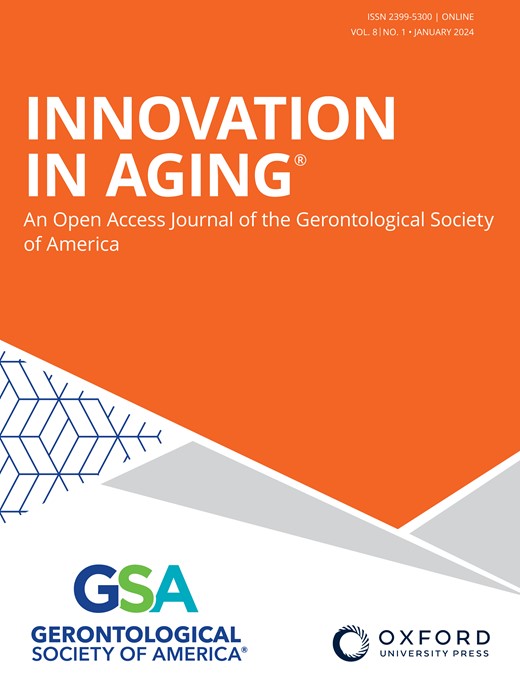体能是中年衰老速度的标志
IF 4.3
3区 医学
Q1 GERIATRICS & GERONTOLOGY
引用次数: 0
摘要
摘要 生物年龄通过对衰老速度的估计来捕捉衰老的异质性。作为广泛研究的衰老实验室生物标志物的替代品,体能的行为功能标志物可为识别有负面衰老轨迹风险的个体提供一种可行的替代方法。我们的目的是研究不同功能测试的组合以及体能综合评分与衰老率之间的关系。我们进行了一项横断面研究,研究对象为中年成人(约 45 岁),他们报告说自己能够进行休闲体育锻炼。生物年龄是通过克莱默拉-杜巴方法和一组生理生物标志物估算的;老化率 ∆Age 被定义为年龄与估算的生物年龄之间的差值。体能是通过与六个体能领域相关联的 15 项功能测试进行测量的。116 名参与者完成了测试。对于女性来说,力量、柔韧性、心肺功能和平衡测试的较好结果与∆年龄呈负相关(r=0.38-0.29,p<0.05);对于男性来说,除这些测试外,敏捷性也与∆年龄呈负相关(r=0.27-0.59,p<0.05)。在控制了实际年龄、吸烟和受教育程度后,体能的性别标准化综合评分与 ∆ 年龄呈负相关(女性和男性分别为 r=-0.437,p=0.007;r=-0.491,p<0.001)。建议的体能电池可对∆年龄进行功能评估。较高的体能指标与较小的Δ年龄相关,与较年轻的生理年龄相对应。测量体能有助于评估衰老轨迹,并提供合适的行为干预目标。本文章由计算机程序翻译,如有差异,请以英文原文为准。
PHYSICAL CAPACITY AS MARKER FOR RATE OF AGING IN MID LIFE
Abstract Biological age captures the heterogeneity of aging by providing an estimation for rate of aging. As an alternative to the widely investigated laboratory biomarkers of aging, behavioral functional markers of physical capacity may offer a feasible alternative for identifying individuals at risk for negative aging trajectory. We aimed to examine the associations of different functional tests both together and as a composite score of physical capacity with rate of aging. We conducted a cross-sectional study, with midlife adults (age ~45) reporting being able to perform leisure physical exercise. Biological age was estimated using the Klemera-Doubal method and a set of physiological biomarkers; rate of aging, ∆Age, was defined as the difference between age and estimated biological age. Physical capacity was measured using a testing battery of 15 functional tests linked with six physical capacity domains. 116 participants completed the testing battery. For women, better results in terms of strength, flexibility, cardiorespiratory fitness, and balance tests were negatively correlated with ∆Age (r=0.38-0.29, p<0.05); for men, beyond these tests, agility was also negatively correlated with ∆Age (r=0.27-0.59, p<0.05). A sex-standardized composite score of physical capacity was negatively associated with ∆Age after controlling for chronological age, smoking, and education (r=-0.437, p=0.007; r=-0.491, p<0.001 for women and men respectively). The suggested physical capacity battery offers a functional assessment for ∆Age. Higher physical capacity metrics correlate with smaller ∆Age, corresponding with younger biological age. Measuring physical capacity may help to assess aging trajectory and offer a suitable behavioral intervention goal.
求助全文
通过发布文献求助,成功后即可免费获取论文全文。
去求助
来源期刊

Innovation in Aging
GERIATRICS & GERONTOLOGY-
CiteScore
4.10
自引率
0.00%
发文量
72
审稿时长
15 weeks
期刊介绍:
Innovation in Aging, an interdisciplinary Open Access journal of the Gerontological Society of America (GSA), is dedicated to publishing innovative, conceptually robust, and methodologically rigorous research focused on aging and the life course. The journal aims to present studies with the potential to significantly enhance the health, functionality, and overall well-being of older adults by translating scientific insights into practical applications. Research published in the journal spans a variety of settings, including community, clinical, and laboratory contexts, with a clear emphasis on issues that are directly pertinent to aging and the dynamics of life over time. The content of the journal mirrors the diverse research interests of GSA members and encompasses a range of study types. These include the validation of new conceptual or theoretical models, assessments of factors impacting the health and well-being of older adults, evaluations of interventions and policies, the implementation of groundbreaking research methodologies, interdisciplinary research that adapts concepts and methods from other fields to aging studies, and the use of modeling and simulations to understand factors and processes influencing aging outcomes. The journal welcomes contributions from scholars across various disciplines, such as technology, engineering, architecture, economics, business, law, political science, public policy, education, public health, social and psychological sciences, biomedical and health sciences, and the humanities and arts, reflecting a holistic approach to advancing knowledge in gerontology.
 求助内容:
求助内容: 应助结果提醒方式:
应助结果提醒方式:


